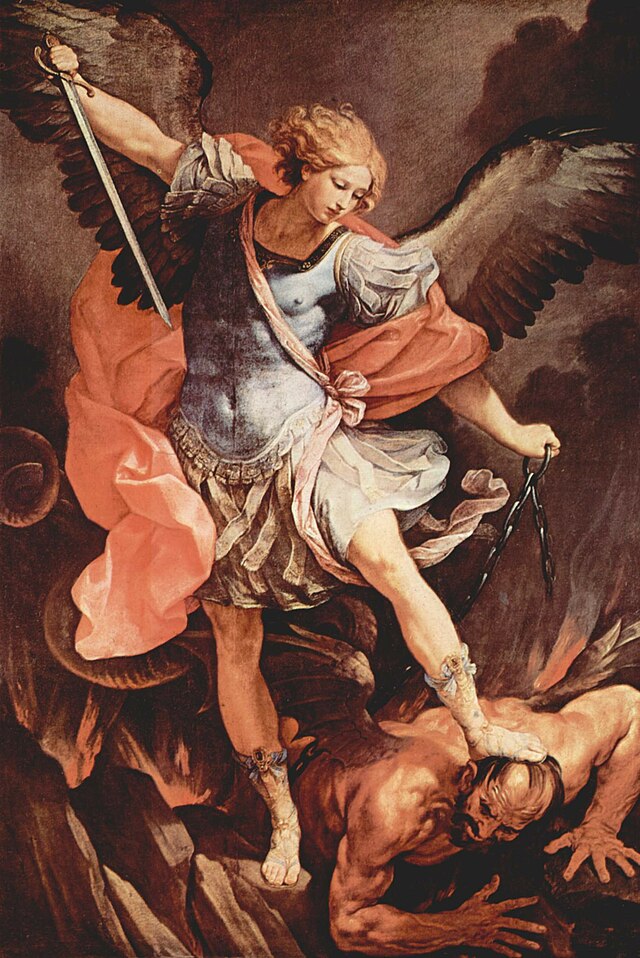
“Archangel Michael reaching to save souls in purgatory . . .”
There’s a church in Stone Mountain – St. Michael & All Angels’ Episcopal – that Yours Truly and his Dulce passed the other day while leaving Stone Mountain Park. That led to the question, “Who the heck is this St. Michael guy?” That led us to Revelation 12:7-10:
[T]here was war in heaven: Michael and his angels fought against the dragon; and the dragon fought and his angels. And prevailed not… [T]he great dragon was cast out, that old serpent, called the Devil, and Satan, which deceiveth the whole world; he was cast out into the earth, and his angels were cast out with him. And I heard a loud voice saying … the accuser of our brethren is cast down, which accused them before our God day and night.
Note that both the Hebrew and Greek words “Satan” (“Satanas” in Greek) translate as “an adversary,” while the root word for devil is “diabolos,” which is Greek for “slanderer.” So you could say that like any good prosecutor, Satan the Accuser – as Ultimate Prosecutor – will try first and most to “convict” you, if and as necessary by slandering your character to God.
But we digress. . .
For more see Michael (archangel) – Wikipedia, which included this:
Michael ([translated] “who is like God?” … ) is an archangel in Jewish, Christian, and Islamic teachings. Roman Catholics, the Eastern Orthodox, Anglicans, and Lutherans refer to him as “Saint Michael the Archangel” and also as “Saint Michael. . .” In the New Testament Michael leads God’s armies against Satan‘s forces in the Book of Revelation, where during the war in heaven he defeats Satan.
St. Michael has a Feast Day – also called Michaelmas Day – on September 29, which means I’ll be doing another post on him around that time. Note also that an archangel is an “angel of high rank.” And Wikipedia noted Michael wasn’t just mentioned in the Book of Revelation:
Michael is mentioned three times in the Book of Daniel, once as a “great prince who stands up for the children of your people.” The idea that Michael was the advocate of the Jews became so prevalent that in spite of the rabbinical prohibition against appealing to angels as intermediaries . . . Michael came to occupy a certain place in the Jewish liturgy.
I’ve included two images of St. Michael, with the one below showing him “trampling Satan.” But the upper image shows him in another of his jobs – “reaching out to souls in purgatory” – which means that he might end up being the archangel who saves my own spiritual butt.
On the other hand, there is that part of the Book of Common Prayer which calls the idea a Romish doctrine, but for myself I say, “Hey, I’ll take all the help I can get!”

The upper image is courtesy of the Wikipedia article on St. Michael, with the full caption, “Archangel Michael reaching to save souls in purgatory, by Jacopo Vignali, 17th century.”
Dulce is Spanish for “Sweet,” or in the alternative Mi Dulce or “My Sweet.” (See also the posts On “St. James the Greater”, and On the “Infinite Frog”, which referred to the time a nice-lady “who happens to be Catholic lit a votive candle ‘on behalf of the poor benighted Protestant soul of Yours Truly.'” Like I said, “I’ll take all the help I can get.”)
As to the definitions of Satan and/or the “Slanderer,” see the New International Dictionary of the Bible, Regency Reference Library, 1987, Page 899.
The lower image is also courtesy of the Wikipedia article, with the full caption: “Guido Reni‘s painting in Santa Maria della Concezione, Rome, 1636 is also reproduced in mosaic at the St. Michael Altar in St. Peter’s Basilica, in the Vatican.”
As to the idea of Purgatory being a “Romish doctrine,” see the Book of Common Prayer at page 872, number XXII of the 1801 Articles of Religion, under Historical Documents of the Church:
The Romish Doctrine concerning Purgatory, Pardons, Worshipping and Adoration, as well of Images as of Relics, and also Invocation of Saints, is a fond thing, vainly invented, and grounded upon no warranty of Scripture, but rather repugnant to the Word of God.
For further information on the post-mortem pardons and Indulgences that led to the “splitting of the one true church,” see Indulgence – Wikipedia, the free encyclopedia, CATHOLIC ENCYCLOPEDIA: Indulgences – New Advent, and/or indulgence (Roman Catholicism) — Encyclopedia Britannica. See also the second section of The March of Folly: From Troy to Vietnam: Barbara W. Tuchman.
Purgatory itself is describe as an “intermediate state” between heaven and hell:
. . .an intermediate state after physical death in which those destined for heaven “undergo purification, so as to achieve the holiness necessary to enter the joy of heaven.” Only those who die in the state of grace but have not in life reached a sufficient level of holiness can be in Purgatory, and therefore no one in Purgatory will remain forever in that state. . .
See Purgatory – Wikipedia, the free encyclopedia. In other words, it’s not quite the “pass-fail” system of reward-and-punishment proclaimed by some Protestant denominations. For another interesting treatment see Heaven and Hell in Christian Thought (Stanford Encyclopedia).